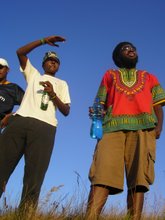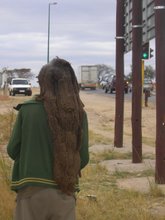In 1864 Mswati's armies attacked the maPulana living next to the Blyde River. The maPulana retreated to the top of the mountain (Mariepskop), some 1 944 metres above sea level, which towers over the magnificent Blyde River Canyon, nearly 1,5 km deep and at least as wide. The maPulana piled up rocks along the top edge of the mountain in readiness in the event of an attack by the enemy. The mountain could only be reached by a single footpath of about 2 km in length. The Swazi were aware that they could not attack the maPulana without any danger on top of the mountain and bivouacked on the mountain north of the Blyde River and waited for misty weather.
It was summer and in cloudy weather Mariepskop is usually covered by thick mist. The Swazi did not wait long. One evening the clouds started rolling in from the south and covered Mariepskop with mist. The Swazi left their camping site and started moving, approaching the mountain from the south. The mist was very dense and they had to move with their hands virtually on the shoulder of the person in front to remain close together. Zimase, the younger brother of Mswati II, was amongst the first group to ascend the mountain.
The maPulana were ready and when the first Swazis reached the top the maPulana rolled the stacked rocks down onto their enemy. While the Swazi were in turmoil, the maPulana swarmed down the hill and started attacking those down at the river on the southern side of the hill. To this day the bones of those who were killed by the rocks may still be seen in the inaccessible rock crevices of the mountain
The maPulana named the mountain Mhuluhulu, which means ‘the mountain of the wind’, because the Swazi only heard the wind of the rocks before they were killed. The river, where the final attack took place and where the Swazi was annihilated, they named ‘Motlasedi’, which means ‘where the big battle took place’. Today the river is known, from Mariepskop to the Klaserie Dam in the river, as the Motlasedi and then as the Klaserie, which is an Afrikaans distortion of the word Motlasedi. The mountain where the Swazi camped was named Swatini, which means ‘the place of the Swazis’. The resort at the foot of this hill is incorrectly named Swadini.
As a result of this defeat, and the death of the King's brother, the remaining Swazis refused to return to Swaziland for fear of death. Most sought asylum in Sekhukhuneland. Others found refuge between the mountains in the southern part of the present Kruger National Park, which was free of Tsetse fly, and named the area Khandzalive, which means ‘they found a settlement’. Another group found a new living place known as Selephi (Selapi) (today known as the farm Sassenheim, 10 km south-west of Barberton). They named this area Mjindini, meaning ‘so far and no further’ as they were also afraid that Mswati would kill them if they returned to Swaziland.
Subscribe to:
Post Comments (Atom)





No comments:
Post a Comment